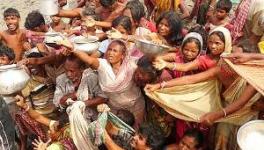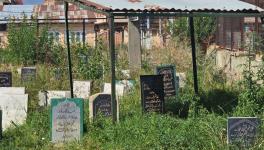Uri, a War Zone? Report From Ground Zero
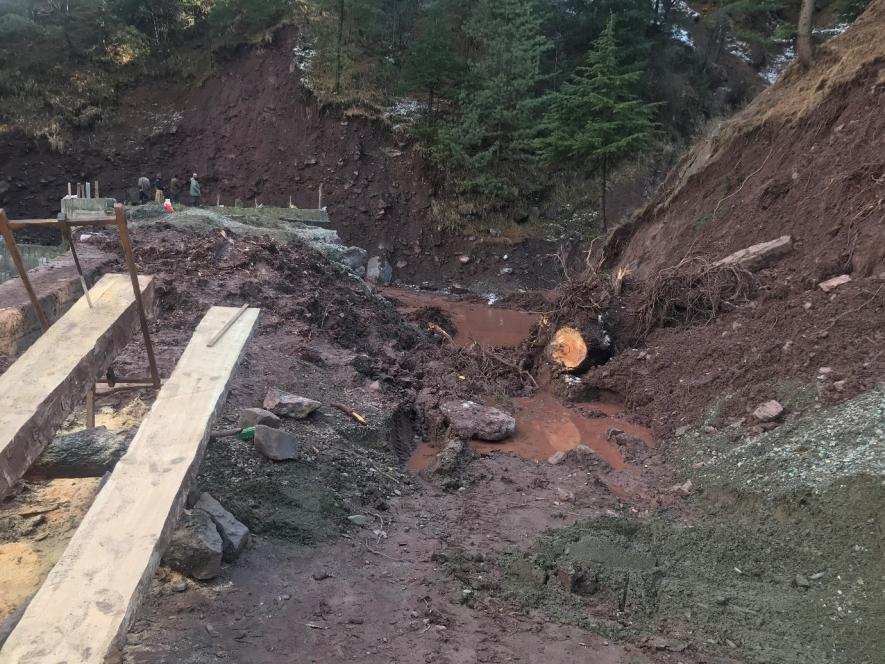
Image Courtesy : Zubair Sofi
Uri: When India and Pakistan were facing each other in the sky, people of Tilawari, an area in Uri sector, were looking for trenches to seek refuge from the artillery strikes. Owing to the dereliction of the roads and the bridges, there is almost no route available to evacuate the civilians as the vehicular access remains disabled.
On the evening of the same day when the India Air Force made an ingress into the Pakistan province to “avenge” the Pulwama attack from North Kashmir – where India and Pakistan share borders from multiple sides, mostly from Pakistan Administrated Kashmir (PAK) – Pakistani army reportedly started firing in Uri, an area of North Kashmir’s Baramulla district.
In response, firing started from this side of Kashmir, and the reinforcements and ammunition were sent to many areas where the firing was continued.
The firing was initiated from both the sides without any warning for the evacuation of civilians from the area. The civilians were forced to remain unsafe in their mud-brick houses (Kotha), which are extremely vulnerable structures. After a while, the firing stopped, and peace was seemingly restored. However, the evacuation was still not carried out.
Many villages in Uri sector such as Chriunda, Silikote, Balkote, Tilawari are located exactly on the border. These villages are highly vulnerable to the collateral damage of the crossfire.
Tilawari, located on the top of the mountain, is at a distance of almost 6 kilometres from main Uri, and is one of the endmost villages on the border, making it an extremely dangerous place for living. But the locals do not have the option of leaving the place.
The only road which connects Tilawari to the rest of the country lies in ruins. The route turns deadlier after every rainfall. The bridge which is the only vein to connect it to the main road to Uri is destroyed by landslides, and is now blocked by huge dunes of mud and broken trees. People have to walk one kilometre in order to reach the village.
In the five 500-strong village, there no dispensary whatsoever within the radius of five kilometres. Whenever there is tension on the border, people spend their nights restlessly, and keep an eye on the last check-post of Pakistan, as it is clearly visible, owing to its elevation.
Tilawari. Picture Courtesy: Zubair Sofi
From the green-roofed check-post of Pakistan, there is always an announcement made before any exchange of fire. The last check-post from this side of the border is New Tika post. But from this post, it is difficult for the Indian Army to watch Pakistani snipers, as it is not elevated enough.
On February 27, when Pakistan retaliated – which was not from Tilawari side though – the whole village was in a panic. There were no orders of evacuation. However, even if there would have been such an order, the evacuation would have been extremely difficult, owing to the broken bridge.
In the morning, after Pakistan Air Force (PAF) attacked the military installations in Indian Provinces in J&K – in Poonch and Rajouri of the Jammu region – IAF, in retaliation, made an ingress into the Pakistani territory, and that’s when the IAF Migs were caught in the air defence ambush, wherein the two IAF jets were shot down. One of the pilots, whose identity was later ascertained as Wing Commander Abhinandan, was captured alive by the Pakistani Army, and remains in their custody.
Also read: India at Crossroads: War or Dialogue?
Moreover, around 10:40 am, in Garend Kalan, some seven kilometre from central Kashmir’s Budgam district, an IAF helicopter crashed into a field, which resulted in the death of six pilots and one civilian. Although the identity of the killed army personnel is still being ascertained, the civilian was identified as Kifayat Hussain Ganaie, a local resident. Officials said that MI-17 crashed after developing a technical snag.
In the wake of these development, even in the absence of an evacuation order, villagers form Tilawari – mostly children – started moving away from the village. On the periphery of the village lie landmines, and one has to cross barricade wires while taking this route. So, the villagers decided to send children and ailing patients to their relatives living in nearby villages.
“Why don’t you seek shelter from the government authorities?” asked this reporter to octogenarian Haji Ghulam Mohammad Mir, whose house is the last in the row, on the edge of the border. “Government Kuch Nei Kerti (Government doesn’t do anything),” he said. His resentment is not solely due to the recent crisis, but because of an old wound which is yet to be healed.
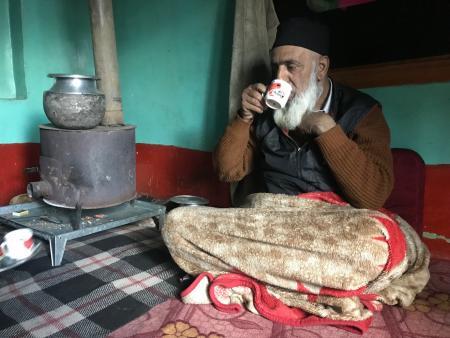
Haji Ghulam Mohammad Mir, Picture courtesy: Zubair Sofi
On February 22, 2018, it was raining outside and Mir was sitting in his kitchen, having breakfast with his family. Before Mir could decide what he has to do for the rest of the day, he heard a loud bang which shook the entire village. “I rushed to the courtyard to figure out what had happened, I saw smoke billowing from my neighbour’s house,” said Mir.
Soon, there was an announcement from Pakistan: “Gaon Khali Kero” (evacuate the village). It was after 17 years that cross-border firing had taken place in Uri.
Panicked villagers started running towards the wrecked bridge, where an ambulance and a few cabs were waiting for them. But all of the villagers were not able to move, as shelling intensified. Mir and his family were stuck.
One of the mortar shells landed on his house, which damaged a major part of it. Mir and his family took refuge in a cowshed, which is a few feet deep into the mountain.
“That was the only place which I thought could be safe,” recalled Mir.
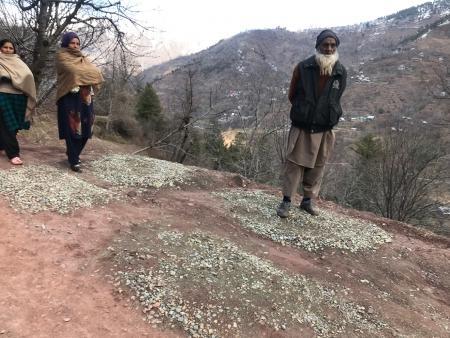
Villagers leaving Tilawari, Picture Courtesy: Zubair Sofi
From the window of the shed, Mir was able to see burning houses in Silikote, another village located on the opposite side of Tilawari. During this cross-border shelling, Silikote and Tilwari were the most affected villages.
After a few hours, even as the shelling continued incessantly, a few local youths managed to reach Silikote, and evacuated a few families who were stuck in the burning houses. Mir was watching the whole scene. The rescued families were sheltered in Uri Higher Secondary School.
Also read: Say NO to War
Mir managed to send his family to Uri, but he decided to stay back.
Next day, when the shelling stopped, people were asked to return to their homes, which was difficult. The atmosphere was still tense.
“One of my sons called me, and said that there was no proper food to eat, all of them were kept in a school, and there were no arrangements for sleeping,” said Mir. “Now they were asking them to leave.”
People were unwilling to return, as they were scared after witnessing the scale of mortar shelling. There were chances of more rounds of shelling as well. However, they were thrashed and were pushed out of the school, said Mir. Some returned to the village, and some chose to go to their relatives’ homes.
Smoke was billowing from the derelict roofs of the houses when Zubeida, Mir’s 28-years-old daughter in law, reached home. “Before she could say anything, tears started rolling down from her eyes. She later told me how cruelly they were treated,” said Mir. “That wrenched my heart.”
After several days, government authorities reached the village to take estimate of the damage, and left with the promise that they will return with compensation. “I never saw them again,” said Mir.
The houses which were damaged in shelling in Silikote belonged to Fayaz Ahmad Awaan, the 47-year-old man whose income source is farming. Most of the land, which was once part of his field where he grew apples, walnuts, almonds, apricots etc., is now filled with landmines. For 10 years, Fayaz has worked for the army as a porter.
While speaking to Newsclick, Fayaz said that from his house till Haji Peer Canal, which flows from Pakistan via Uri, all the land is filled with mines. “I have lost a big chunk of my cattle due to the mines. I have to keep a vigil on my children when they go out in the courtyard to play, lest they venture into the area wrought with landmines.
Living alongside the border makes life extremely difficult for Sillikote villagers. The army has erected a gate at some distance from the village, which opens for movement at 7 am, and closes at 7 pm. If someone has to enter village after 7 pm – possibly due to the lack of transport facility in the area – they have to go back four kilometre, and seek permission from concerned army major for entry.
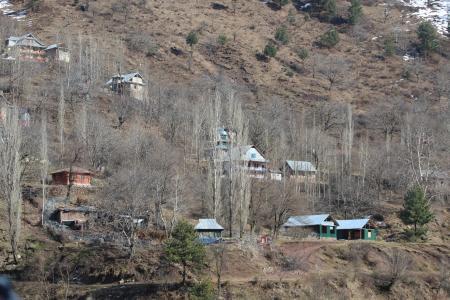
Silikote, Picture courtesy: Zubair Sofi
Since his house was razed to the ground, Fayaz has been living in a panchayat house along with his six family members. He has approached the government authorities too many times for his compensation, he says, but hasn’t got any positive response.
“No doubt we are living in a war zone, but it should be guns against guns, jets against jets. We are civilians. Are we supposed to live a horrible life like this? are we supposed to die with a bullet in our body?” asked Fayaz, with tears in his eyes.
Also read: India-Pakistan: Revenge, Response and Retaliation
Get the latest reports & analysis with people's perspective on Protests, movements & deep analytical videos, discussions of the current affairs in your Telegram app. Subscribe to NewsClick's Telegram channel & get Real-Time updates on stories, as they get published on our website.










